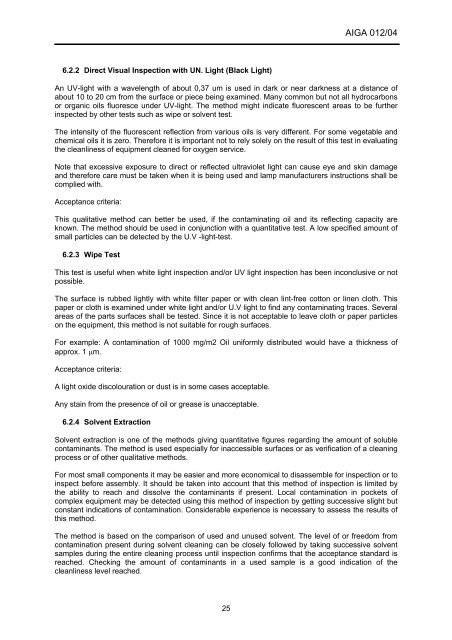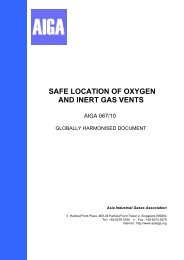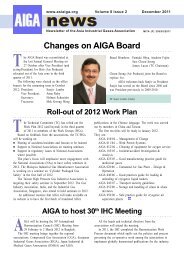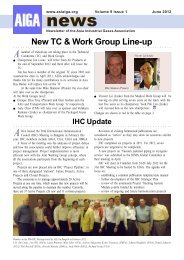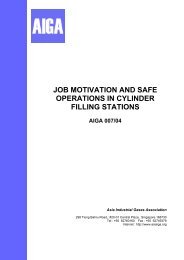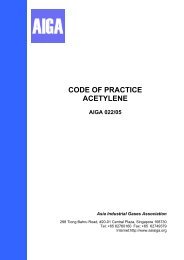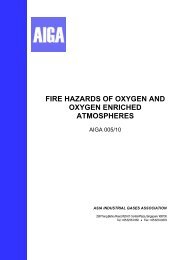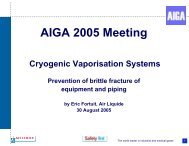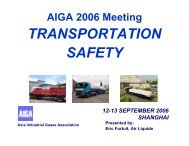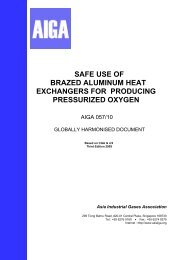CLEANING OF EQUIPMENT FOR OXYGEN SERVICE - AIGA
CLEANING OF EQUIPMENT FOR OXYGEN SERVICE - AIGA
CLEANING OF EQUIPMENT FOR OXYGEN SERVICE - AIGA
You also want an ePaper? Increase the reach of your titles
YUMPU automatically turns print PDFs into web optimized ePapers that Google loves.
6.2.2 Direct Visual Inspection with UN. Light (Black Light)<br />
25<br />
<strong>AIGA</strong> 012/04<br />
An UV-light with a wavelength of about 0,37 um is used in dark or near darkness at a distance of<br />
about 10 to 20 cm from the surface or piece being examined. Many common but not all hydrocarbons<br />
or organic oils fluoresce under UV-light. The method might indicate fluorescent areas to be further<br />
inspected by other tests such as wipe or solvent test.<br />
The intensity of the fluorescent reflection from various oils is very different. For some vegetable and<br />
chemical oils it is zero. Therefore it is important not to rely solely on the result of this test in evaluating<br />
the cleanliness of equipment cleaned for oxygen service.<br />
Note that excessive exposure to direct or reflected ultraviolet light can cause eye and skin damage<br />
and therefore care must be taken when it is being used and lamp manufacturers instructions shall be<br />
complied with.<br />
Acceptance criteria:<br />
This qualitative method can better be used, if the contaminating oil and its reflecting capacity are<br />
known. The method should be used in conjunction with a quantitative test. A low specified amount of<br />
small particles can be detected by the U.V -light-test.<br />
6.2.3 Wipe Test<br />
This test is useful when white light inspection and/or UV light inspection has been inconclusive or not<br />
possible.<br />
The surface is rubbed lightly with white filter paper or with clean lint-free cotton or linen cloth. This<br />
paper or cloth is examined under white light and/or U.V light to find any contaminating traces. Several<br />
areas of the parts surfaces shall be tested. Since it is not acceptable to leave cloth or paper particles<br />
on the equipment, this method is not suitable for rough surfaces.<br />
For example: A contamination of 1000 mg/m2 Oil uniformly distributed would have a thickness of<br />
approx. 1 µm.<br />
Acceptance criteria:<br />
A light oxide discolouration or dust is in some cases acceptable.<br />
Any stain from the presence of oil or grease is unacceptable.<br />
6.2.4 Solvent Extraction<br />
Solvent extraction is one of the methods giving quantitative figures regarding the amount of soluble<br />
contaminants. The method is used especially for inaccessible surfaces or as verification of a cleaning<br />
process or of other qualitative methods.<br />
For most small components it may be easier and more economical to disassemble for inspection or to<br />
inspect before assembly. It should be taken into account that this method of inspection is limited by<br />
the ability to reach and dissolve the contaminants if present. Local contamination in pockets of<br />
complex equipment may be detected using this method of inspection by getting successive slight but<br />
constant indications of contamination. Considerable experience is necessary to assess the results of<br />
this method.<br />
The method is based on the comparison of used and unused solvent. The level of or freedom from<br />
contamination present during solvent cleaning can be closely followed by taking successive solvent<br />
samples during the entire cleaning process until inspection confirms that the acceptance standard is<br />
reached. Checking the amount of contaminants in a used sample is a good indication of the<br />
cleanliness level reached.


